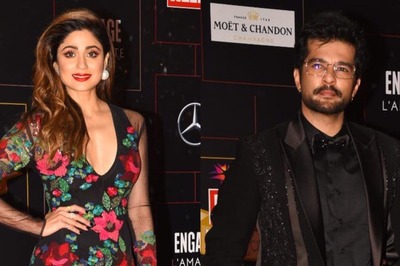
views
Last month, the Karnataka Congress flagged off its election bus yatra from ‘Congress Well’ in Belgaum.
The All India Congress Committee (AICC) session presided over by Mahatma Gandhi was held in Belgaum in 1924 and a well was dug to provide drinking water to the delegates. The well is now a monument and the State Congress, which hopes to dislodge the Bharatiya Janata Party (BJP) in the Assembly elections due in the next two months, wants to use it as a symbol.
The other reason is mobilising the dominant Lingayat community votes in favour of the Congress. The Mumbai-Karnataka region, now called Kittur Karnataka region, with 56 Assembly seats is a Lingayat stronghold and a bastion of the BJP over the past two decades. With the declining clout of BS Yediyurappa, both within BJP and among the Lingayats, the Congress is trying to woo some of them back into the party fold.
Lingayats, politically, economically, and socially the most powerful community in the state have had an uneasy relationship with the Congress over the past 100 years. Interestingly, starting from then Congress president Mahatma Gandhi to immediate past president Rahul Gandhi have tried their best to manage the Lingayats.
Even though the Congress, after the unification of Karnataka in 1956, was dominated by the Lingayats till the split of party in 1969, contrary to popular belief, Lingayats were wary of it and dubbed the Congress as a Brahmin-Bania party.
PRE-INDEPENDENCE
According to a senior Supreme Court advocate Mohan Katarki, who is also from the Mumbai-Karnataka region, the Lingayats have had uncomfortable relationship with Congress in the pre-Independence days. The Lingayats, Marathas and Patidars, who were the dominant landowners in Bombay Presidency extending from Sindh in Pakistan to Tungabhadra river bordering the princely State of Mysore, were attracted towards the Justice Party, which had its base in Madras Presidency, on a common platform of Non-Brahmin politics. Mahatma Gandhi, who was scouting for support of dominant communities to launch the freedom movement in a more meaningful manner, succeeded in turning the Patidars towards the Congress through Sardar Vallabhai Patel and his brother.
However, Gandhi’s efforts in persuading Sir ST Kambli, who was the leader of Lingayats from Hubli, (Gandhi personally called on him in Hubli) and Sir BV Jadhav, who was leader of Marathas from Satara, failed.
Both continued in the Justice Party and occupied the coveted offices as Ministers in Bombay Government during dyarchy system introduced under the Government of India Act of 1915-19. The Congress session in Belgaum proved to be an embarrassing moment for the Congress leaders when the British taunted that the local dominant community Lingayats are not backing the Congress session.
However, things changed in the mid-1930s. The growing middle class in Lingayat community plunged into the freedom movement under the leadership of MP Patil, Hallikeri Gudleppa, Sardar Veeranagouda Patil, KF Patil, SR Kanthi and others. After Independence, Lingayats continued with the Congress in Bombay, although their flirting with Justice Party was held against them.
The reorganisation of States in 1956 enlarged the field of Lingayat politics. The new Mysore State renamed as Karnataka in 1973 became a centre of activity, but focus shifted from Lingayat to Veerashaiva (a dominant Shaivaite sect in Old Mysore region). Between 1956 and 1971, Lingayats along with Vokkaligas dominated the politics in Congress. The successive Chief Ministers were from Lingayat community BD Jatti, S Nijalingappa, SR Kanthi and Veerendra Patil. Incidentally, all these men were from the same sub sect of Banajiga, the prominent traders and merchants among the Lingayats.
Interestingly, current chief minister Basavaraj Bommai’s maternal grandfather advocate Hurlikuppi was also a Justice Party leader and an MLA from CM’s constituency Shiggaon in the Bombay Presidency.
The Congress split in 1969 took Lingayats in a different direction. The community led by S Nijalingappa veered towards the old Congress as different from the Indira Congress. Probably a strategic mistake. The community lost its dominant position in the power game and since then, it has been out of the Congress politics, except briefly in 1989-1990 when Veerendra Patil led the Congress party to massive victory with more than 175 seats. But he was soon unseated. Lingayats, feeling let down, shifted to the BJP in mid-1990s and finally, their mighty clout in rural areas of north Karnataka brought the BJP to power in 2008, Katarki points out.
POST-INDEPENDENCE
In the early 1950s, at the height of Karnataka Ekeekarana Andolana (Karnataka Unification Movement), top leaders of the Vokkaliga caste had gathered at a house in central Bengaluru to decide the future course of their action. All of them were Congress leaders and had participated in the freedom movement. Most had impeccable personal credentials. But a majority of them were not too enthusiastic about the unification of all Kannada-speaking areas under one administration.
They had many reasons for that. Some argued that Maharaja’s Mysore or Old Mysore was already a well-developed model state and merging poor Mumbai-Karnataka and Hyderabad-Karnataka regions would be a burden on the state exchequer and resources. Some had bigger fears. They argued that once all Kannada-speaking areas unite, the Vokkaligas will lose their caste dominance paving way for the Lingayat hegemony. Two most powerful castes of the state were wary of each other even then.
But the then chief minister of old Mysore state, Kengal Hanumanthaiah, was all for state unification. A freedom fighter and an able administrator, Hanumanthaiah was a tall leader of the Vokkaligas.
Vetoing his own caste leaders, Hanumanthaiah told them that future generations of Kannadigas would never forgive them if they opposed unification for caste and political reasons.
The Vokkaliga leader threw his might behind the unification movement and the new Mysore state with Kannada-speaking regions of Bombay Presidency, including some districts of present-day Karnataka, Nizam’s Hyderabad, Karnataka, Madras Presidency and an independent, tiny state of Kodagu (Coorg), was born on November 1, 1956.
Sadly, Hanumanthaiah lost power and a Lingayat strongman, S Nijalingappa, took charge as the first chief minister of New Mysore state. As expected, the Vokkaligas lost the chief minister’s chair to Lingayats and they had to wait for 38 years to reclaim the chair. In 1994, H D Deve Gowda became the first Vokkaliga chief minister of united Karnataka.
Between 1956 and 1972, four Lingayat chief ministers — S Nijalingappa, B D Jatti, S R Kanthi and Veerendra Patil — ruled the state. Between 1972 and 1983, a Kshatriya, D Devaraja Urs, and a Brahmin, R Gundurao, ruled the state minus much Lingayat backing. Ramakrishna Hegde, who became Karnataka’s first non-Congress chief minister in 1983, was also considered an uncrowned Lingayat leader, even though he was a Brahmin.
To end Hegde’s rule, then Prime Minister and Congress president Rajiv Gandhi made a Lingayat stalwart Veerendra Patil the president of KPCC and chief ministerial candidate in 1989. Under his leadership, the Congress swept the polls by winning 181 seats in the 224-member house.
After Patil was unceremoniously removed by Rajiv Gandhi at Bengaluru airport in October 1990, the Lingayats once again started moving away from the Congress. In 1994, the combined strength of Lingayats and Vokkaligas decimated the Congress which managed to win just 36 assembly seats under then Chief Minister M Veerappa Moily.
These instances prove that without Lingayats’ backing no political party in Karnataka can really come to power and even if it manages, it may not be able to remain in power for long. Since the unification of state, Lingayats have dominated the socio-political life of Karnataka, forcing the Vokkaligas to play second fiddle to them. With their political and economic power, the Lingayats control the biggest vote bank in the state.
Contrary to the recent claims of the saffron parivar, Lingayats are not the traditional backers of the BJP. They were once the backbone of the Congress in Karnataka. After Devaraja Urs ended Lingayat hegemony in the party, they shifted to Janata Parivar. After the disintegration of the Janata experiment, they started backing the BJP and accepted B S Yediyurappa as their leader.
NUMBERSPEAK
In the 2018 Assembly elections, 55 Lingayat MLAs won (38 BJP, 13 Congress and 4 JDS). In 1989, there were 89 of them. It came down to 68 in the subsequent assembly polls held in 1994. With Other Backward Classes (OBCs) asserting their power during and post Devaraj Urs era, the Lingayat representation is declining in the Assembly. But they still form 20-25% of the MPs and MLAs from the state irrespective of the party in power.
According to political analysts, Lingayats decide the outcome in close to 100 Assembly seats and 14 Lok Sabha seats in the state. In Mumbai-Karnataka and Hyderabad-Karnataka regions, they are the deciding factor in about 70 Assembly seats. These two regions together have 94 Assembly seats and 12 Lok Sabha seats.
In Vokkaliga-dominated Old Mysore region with 89 Assembly seats, Lingayats play an important role in deciding the fate of candidates in about 30 Assembly seats. According to some unauthenticated data, Lingayats have 30-35% population in 85-90 Assembly seats and they have 10-15% population in 45-50 seats.
Even though the Lingayats claim their population is over 17% of the state’s total population, the leaked “caste census” report says they form 14% of the population and count only after Dalits and Muslims with 19.5% and 16% respectively, insiders claim. The Vokkaligas have 11% population, the census reveals.
With majority Vokkaligas firmly supporting Gowda’s JDS, breaching BJP’s Lingayat fortress would be the most brilliant thing to do only if it works. If the Congress fails to get at least 25-30% Lingayat votes, it will be almost impossible to reach the halfway mark of 113. If the BJP can retain majority Lingayat votes, it can still be the single largest party, if not the party with a clear majority.
Both opposition Congress and JDS are planning to field maximum number Lingayat candidates in the coming Assembly elections to dent the BJP’s prospects.
The ongoing agitation for the reservation for Panchamasali sect among the Lingayats might work against the ruling BJP and in favour Congress, some observers argue. Panchamasali are the largest sub-sect among the Lingayats and play a big role in Mumbai-Karnataka region.
Most political analysts and strategists who understand Karnataka’s castes and sub-castes agree that the party that gets castes right, will get the election results right.
Read all the Latest Politics News here


















Comments
0 comment